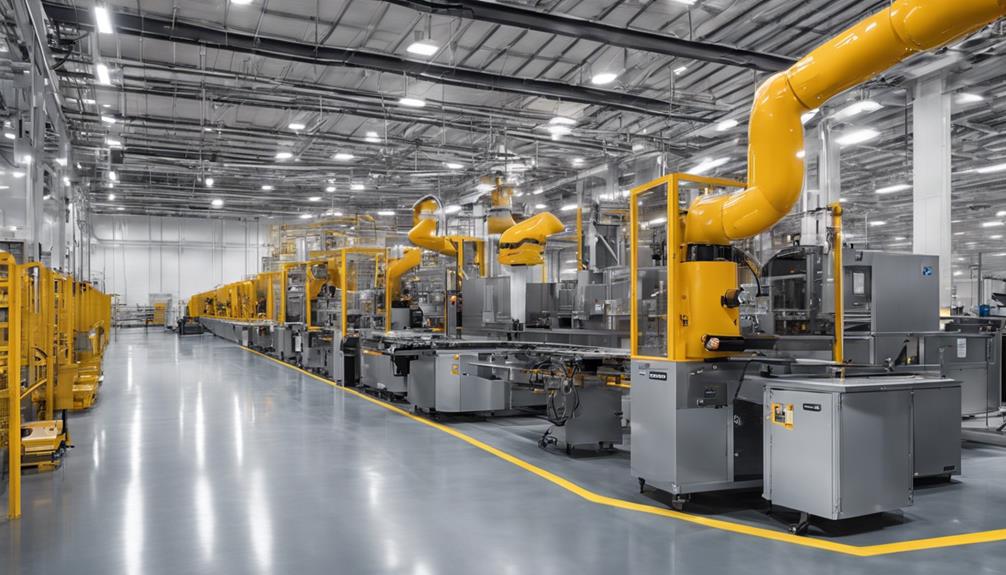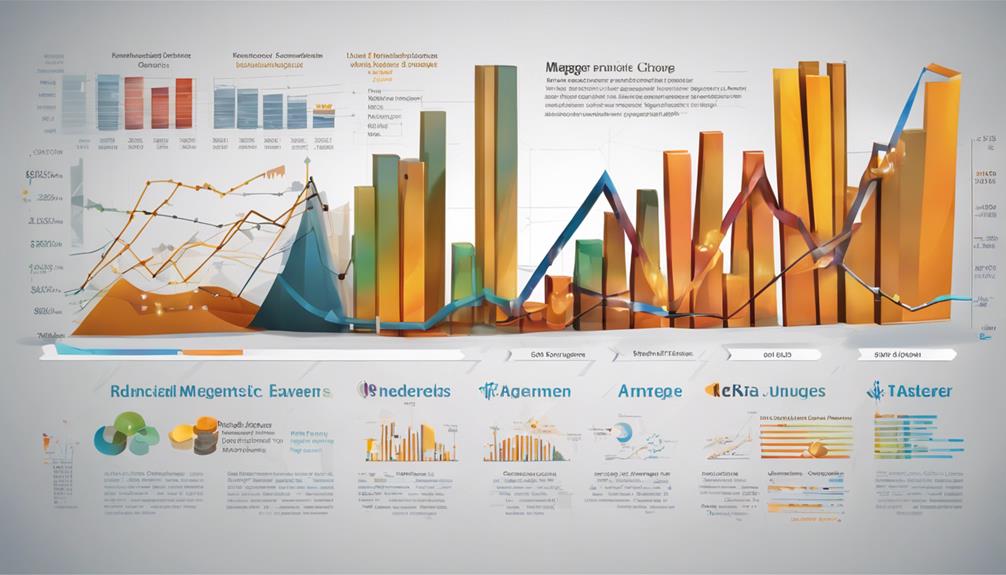Key Factors in Evaluating Horizontal Merger Opportunities

When considering horizontal mergers, it's crucial to assess the level of market concentration using the Herfindahl-Hirschman Index. This index helps us understand how competitive the market will be post-merger. By examining this, we can determine if the merger will significantly impact competition and potentially harm consumers.
Additionally, evaluating the strategic fit and synergies between the merging companies is essential. Companies must ensure that their business models align well and that they can leverage each other's strengths to create value post-merger. This strategic alignment will help maximize the benefits of the merger and drive success in the market.
Regulatory implications also play a significant role in evaluating horizontal merger opportunities. Antitrust laws must be carefully considered to ensure compliance and avoid any legal challenges. By conducting a thorough review of regulatory requirements, companies can mitigate risks and ensure a smooth merger process.
Moreover, analyzing the potential for operational efficiencies and cost savings is crucial. Merging companies should identify areas where they can streamline operations, reduce duplicate functions, and achieve cost synergies. This will not only improve their bottom line but also enhance their competitive position in the market.
Post-merger innovation and maintaining a competitive edge are key factors to consider. Companies must continue to innovate and adapt to market changes to stay ahead of the competition. A detailed due diligence process can help identify areas for innovation and ensure a successful post-merger integration.
Ultimately, aligning stakeholders and planning for a seamless merger integration are critical to realizing the full benefits of a horizontal merger. By involving all key stakeholders early in the process and developing a comprehensive integration plan, companies can ensure a smooth transition and maximize the value created by the merger.
Key Takeaways
- Use the Herfindahl-Hirschman Index (HHI) to measure market concentration and understand its impact on competition and potential regulatory scrutiny.
- Explore synergies between the merging companies, such as cost savings, increased market share, and improved post-merger performance.
- Evaluate cultural fit and integration to ensure a seamless transition and the development of a cohesive corporate culture.
- Ensure compliance with antitrust laws and regulations to reduce risks and preserve customer choice and market competition.
- Analyze the financial impact, including revenue growth, enhanced productivity, and sustainable long-term benefits.
Assessing Market Concentration Levels
Let's dive into market concentration levels, which we can measure using the Herfindahl-Hirschman Index (HHI). The HHI looks at market shares of all firms to assess competitiveness, with higher scores indicating more concentration. This information is crucial for Antitrust authorities to evaluate the potential impact of a merger on market competition and consumer welfare.
Understanding market concentration helps us spot risks like reduced competition, increased prices, and potential market power abuse after a merger. By analyzing these concentration levels, we can gauge the regulatory scrutiny a horizontal merger might face and its impact on overall market dynamics.
Evaluating Strategic Fit and Synergies

When considering a horizontal merger, it's crucial to evaluate the cultural fit between the merging companies. Understanding how well their values, norms, and ways of working align can indicate how smoothly the integration process will go. Cultural clashes can impede progress and hinder the realization of synergies.
Assessing the synergies that could result from combining resources, expertise, and capabilities is another key aspect of evaluating a horizontal merger. By quantifying the potential benefits that the merged entity could achieve, such as cost savings, increased market share, or enhanced innovation, we can better predict the merger's success. Synergies play a significant role in driving the post-merger performance and long-term sustainability of the combined company.
Assessing Cultural Alignment
Assessing cultural alignment plays a crucial role in evaluating the strategic fit and potential synergies between merging companies. When merging, it's important to carefully analyze the compatibility of organizational values, communication styles, and work practices to uncover any underlying challenges that could hinder a successful integration. By delving into the cultural nuances and leadership approaches of each organization, we can pinpoint potential conflicts, address employee concerns, and establish a unified organizational culture post-merger.
To aid in this assessment, a cultural alignment matrix can serve as a valuable visual tool:
| Organizational Characteristic | Company A | Company B | Alignment |
|---|---|---|---|
| Vision & Mission | Convergent | Partially Aligned | Strong |
| Core Values | Harmonized | Divergent | Weak |
| Communication Styles | Direct | Indirect | Moderate |
| Work Practices | Traditional | Innovative | Moderate |
Evaluating this cultural alignment is essential for achieving strategic coherence and unlocking the anticipated synergies of the merger. It empowers us to devise a comprehensive integration strategy that ensures a seamless transition and fosters effective collaboration between the merging entities.
Quantifying Potential Synergies
To quantify the potential synergies of a merger, it's crucial to thoroughly assess how well the merging companies' strategies align. We need to scrutinize how their products, services, and target markets complement each other to pinpoint areas where they can benefit from combining forces.
Identifying opportunities to cut costs by streamlining operations, removing redundant functions, and pooling resources is essential. It's also important to evaluate the potential for boosting revenue through cross-selling, reaching new markets, and offering enhanced products.
Understanding the impact on market share, competitive positioning, and industry dynamics helps us put a number on the strategic alignment. Taking into account factors like cultural fit, leadership alignment, and operational integration challenges is key to ensuring that synergies can be realized successfully.
Regulatory Implications and Compliance

When considering a horizontal merger, it's essential to be aware of the various types of mergers and acquisitions. Horizontal mergers involve companies that are direct competitors in the same industry. These mergers aim to consolidate market share, increase efficiency, and potentially reduce competition in the market.
In a horizontal merger, the merging companies operate in the same line of business and produce similar products or services. By combining their operations, these companies can benefit from economies of scale, streamline processes, and enhance their competitive position in the market.
Regulatory authorities closely scrutinize horizontal mergers to ensure compliance with antitrust laws. They assess market concentration to prevent monopolistic behavior, evaluate entry barriers to new competitors, and analyze the impact on overall competition and consumer choice.
Understanding the implications of antitrust regulations and ensuring strict compliance is crucial when pursuing a horizontal merger opportunity. By navigating these regulations effectively, companies can mitigate risks, protect consumer welfare, and ensure the success of the proposed merger.
Impact on Competition and Consumers

We'll assess market concentration to understand the impact on competition.
By evaluating pricing, output, innovation, and efficiency, we can determine how consumers might be affected.
This analysis is crucial for regulatory approval and the long-term success of the horizontal merger.
Market Concentration Analysis
Market concentration analysis looks at how competitive an industry or market is, giving us important insights into what could happen when two companies merge. We check how much of the market the merging companies will have together to see if they'll have too much power after merging. This helps antitrust regulators spot any signs of unfair competition and protect consumers.
When market concentration goes up after a merger, a few things might happen:
- Less competition, which could affect prices and the types of products available
- Less innovation because there's less pressure to compete
- Higher chances of one company acting like a monopoly, which could hurt consumers
Checking market concentration is crucial for understanding how competitive a market is and how consumers might be affected. By looking closely at these things, we can make sure that mergers are good for the market and the people in it.
Price and Output Effects
When evaluating horizontal mergers, it's crucial to consider how they can impact prices and output levels in the market. These factors directly affect competition and consumer welfare.
After a merger, antitrust authorities need to ensure that consumers aren't harmed by reduced competition. Mergers in the same industry have the potential to decrease product variety and output, limiting consumer choices and access to diverse options.
Consolidating market power through horizontal mergers can also influence pricing strategies. This may result in price increases that negatively impact consumers. It's essential to assess both the price and output effects post-merger to understand how competition will be affected and to protect consumer interests.
Innovation and Efficiency
Horizontal mergers have the potential to not only impact prices and outputs but also drive innovation and improve operational efficiency, benefiting both competition and consumers. Research has shown that post-merger, companies often focus on enhancing their innovative practices, leading to advancements in product development and technology. By staying ahead of the curve and meeting changing consumer demands, merged entities can strengthen their market position and attract more customers.
Furthermore, horizontal mergers can result in streamlined processes and significant cost savings for the companies involved. These efficiencies can then be passed on to consumers through more competitive pricing and improved overall value. This not only benefits customers but also helps the merged entity to remain competitive in the market by offering better products and services.
Moreover, the combined resources and expertise of the merged companies can enhance their market competitiveness. By leveraging their strengths and capabilities, the merged entity can deliver superior products and services, creating a more compelling offering for consumers. This increased competitiveness can drive further innovation and value creation in the industry, ultimately benefiting both businesses and consumers alike.
Operational Efficiencies and Cost Savings

Horizontal mergers help improve operational efficiencies and cut costs by getting rid of duplicate functions and simplifying processes across the combined company. Taking advantage of economies of scale allows for the use of increased purchasing power to lower expenses through bulk purchases and shared resources.
Bringing together IT systems and aligning operational procedures can result in significant cost savings and increased productivity company-wide.
After a merger, optimizing supply chains and logistics can lead to reduced costs and improved operational efficiency. Efficiently managing human resources and enhancing workforce practices can also lead to cost savings and operational improvements.
These strategies enable companies to make the most of horizontal merger opportunities, enhancing their competitive edge through innovation and efficiency gains.
Financial Benefits and Value Creation

Horizontal mergers not only lead to operational efficiencies and cost savings but also bring significant financial advantages and create considerable value for the merged entity. One of the primary financial benefits is revenue growth, which stems from expanding the customer base and reaching a broader audience. Additionally, horizontal mergers can enhance productivity, boost market share, and improve competitiveness within the industry, thereby contributing to increased profitability and stronger profit margins.
Valuation methods such as discounted cash flow (DCF), comparable company analysis (CCA), and precedent transactions play a crucial role in assessing the financial implications and potential value creation of a horizontal merger. Evaluating the financial health, performance projections, and key metrics of the combined entity post-merger is vital to ensuring the success and maximizing the value generated by the transaction.
Ultimately, the financial advantages of horizontal mergers, including synergies and economies of scale, can result in significant competitive benefits and enhanced shareholder value. By strategically combining resources and capabilities, organizations can strengthen their market position and drive sustainable growth in the long run.
Corporate Culture and Employee Impact

Understanding corporate culture and its impact on employees is crucial when assessing horizontal merger opportunities. It's important to consider cultural compatibility to ensure a seamless integration process post-merger.
By understanding how the merger will affect employees, we can anticipate potential resistance, morale issues, and retention challenges early on. This knowledge allows us to address any cultural differences, align values, and promote collaboration between the merging teams.
Effective employee engagement, communication, and change management strategies are essential for a successful integration. Prioritizing employee well-being, training, and development can create a positive work environment and enhance productivity, leading to the success of the combined organization.
When evaluating potential horizontal mergers, it's vital to recognize the significant role that corporate culture and employee impact play in unlocking the full benefits of the transaction. Taking a comprehensive approach enables us to make informed decisions and maximize value creation.
Innovating and Competing Post-Merger

How can we make the most of the combined resources and talent of the merged entities to drive innovation and maintain a competitive edge in the market? By focusing on creating products that meet customer needs, fostering a flexible and adaptable culture, and implementing efficient operational processes, we can unleash the full potential of the post-merger organization.
Understanding the evolving needs and preferences of our customers is crucial for effective innovation and competition. This understanding will guide our product development efforts to ensure they resonate with the market. Encouraging collaboration and creativity in our teams will help us anticipate industry trends and respond quickly to changing demands.
Comprehensive Due Diligence Process

To ensure a successful horizontal merger, it's essential to conduct a thorough due diligence process that carefully examines the financial statements, market trends, and competitive landscape of the target company. This detailed evaluation will help uncover potential synergies, assess cultural alignment, and identify any operational challenges that may arise during the integration process.
Additionally, it's crucial to identify any regulatory issues, antitrust concerns, and legal risks that could impact the approval and execution of the merger. A comprehensive review of the customer base, product portfolios, and intellectual property rights will provide valuable insights into the combined entity's value and potential.
By conducting a meticulous due diligence process, risks can be minimized, hidden liabilities can be uncovered, and a solid foundation can be established for a strategic and successful horizontal merger.
Through a rigorous analysis of all relevant factors, informed decisions can be made to navigate the complexities of the deal, ultimately positioning the merged organization for long-term growth and innovation.
Stakeholder Considerations and Alignment

When considering horizontal mergers, it's crucial to ensure that all stakeholders are aligned. Effective communication and engagement strategies will be key in this process to ensure a smooth integration. By understanding the needs and priorities of employees, shareholders, and customers, we can develop a comprehensive post-merger plan that addresses their concerns and sets the stage for long-term success.
Horizontal mergers involve companies operating in the same industry, which can lead to increased market share and efficiency gains. This type of merger can result in significant cost savings and synergies, benefiting both the companies involved and their stakeholders. It's essential to carefully analyze the potential impact on competition and market dynamics to ensure a successful integration process.
By focusing on stakeholder interests and actively involving them in the merger process, companies can mitigate risks and maximize the opportunities presented by a horizontal merger. Transparent communication, clear objectives, and a shared vision for the future will be essential in building trust and ensuring a positive outcome for all parties involved.
Alignment Among Stakeholders
Horizontal mergers require careful alignment of interests among key stakeholders: shareholders, employees, customers, and regulatory bodies. This alignment is crucial for a successful transition and to maximize the value created from the merger. Understanding the specific needs and expectations of each stakeholder group is essential for a smooth integration process.
Shareholder interests must be aligned by focusing on maximizing synergy and value creation, while also ensuring alignment with regulatory requirements to mitigate risks and address any concerns that may arise. By addressing these aspects, the merger can proceed smoothly and effectively.
Employee expectations should be met through transparent communication strategies that help build positive relationships and a collaborative culture post-merger. Engaging with employees and keeping them informed throughout the process can lead to a more seamless integration and help retain valuable talent within the organization.
Prioritizing customer needs is also crucial in a horizontal merger, as it demonstrates a commitment to maintaining quality and service standards. By ensuring that customers are taken care of during and after the merger, the organization can strengthen trust and loyalty, ultimately leading to a more successful integration.
Stakeholder Communication Strategy
Effective stakeholder communication is crucial in a horizontal merger. Understanding, reducing uncertainty, and building trust are key elements of a successful communication strategy. Addressing stakeholder concerns, providing updates, and staying transparent align stakeholders' interests, goals, and expectations. This alignment minimizes resistance and eases post-merger integration.
Clear and consistent communication engages stakeholders, minimizes disruptions, and fosters a unified approach to achieving merger goals. Strategic communication helps navigate merger complexities, ensuring employees, investors, and regulators are aligned with the process. Prioritizing stakeholder communication leads to a smooth and valuable merger outcome for all involved parties.
Stakeholder Engagement Process
Effective stakeholder engagement plays a crucial role in the success of a horizontal merger. It's essential to thoroughly evaluate the impact on employees, corporate culture, market dynamics, and regulatory compliance, ensuring their interests are aligned to reduce resistance and facilitate a smooth post-merger integration.
Our approach to stakeholder engagement includes:
- Proactively communicating with shareholders, employees, and customers to understand their concerns and address them openly and transparently.
- Collaborating with regulatory authorities to ensure compliance and navigate the approval process seamlessly.
- Cultivating a shared vision and corporate culture that amalgamates the strengths of both organizations, empowering employees and fostering trust.
Merger Integration and Implementation Planning

When two companies come together through a merger, it's crucial to align their structures, processes, and cultures to ensure a seamless integration. This alignment is the key to minimizing disruptions and speeding up the realization of the benefits expected from the merger.
Effective planning and implementation are essential to overcome operational challenges, communicate changes clearly, and reach synergy goals. By setting up detailed timelines, assigning responsibilities, defining milestones, and establishing performance metrics, the post-merger success can be secured.
The outcomes of integration planning include the alignment of organizational structures, streamlined processes, cultural cohesion, and synergy capture. These outcomes lead to reduced risks, minimized disruptions, accelerated value creation, and the achievement of strategic objectives.
Investing in comprehensive integration planning is vital for maximizing value creation in a horizontal merger. By focusing on alignment, operational readiness, and performance management, we can confidently navigate the complexities of post-merger integration and unlock the full potential of the combined entity.
Frequently Asked Questions
What Are the Three Principal Motivations for Horizontal Mergers?
Horizontal mergers are typically pursued for three main reasons: to increase market share, lower operational costs, and gain a competitive advantage. By joining forces with a similar company, businesses aim to expand their presence in the market and solidify their position among competitors. This can lead to a stronger market presence and greater influence in industry dynamics.
Additionally, horizontal mergers can help companies streamline their operations and achieve cost efficiencies through economies of scale. By combining resources and eliminating duplicate functions, organizations can reduce expenses and improve overall profitability. This can ultimately lead to increased shareholder value and sustainable growth in the long term.
Furthermore, horizontal mergers enable companies to access new technologies, distribution channels, and product offerings that they may not have had access to independently. This can provide a strategic edge in the market and enhance the company's ability to innovate and adapt to changing consumer preferences. Ultimately, horizontal mergers can be a strategic move to drive growth, enhance competitiveness, and create value for stakeholders.
What Are the Characteristics of a Horizontal Merger?
In a horizontal merger, we merge companies operating in the same industry. This type of merger aims to increase economies of scale, strengthen industry competitiveness, and expand market share by combining resources, expertise, and customer base. By joining forces, companies can achieve synergies in production, distribution, and technology, leading to cost savings and improved efficiency throughout the supply chain. Additionally, the combined entity can diversify its product offerings, adapt to changing market trends, and enhance regulatory compliance to better meet customer needs and preferences.
What Advantage Would a Horizontal Merger With a Competitor Have?
A horizontal merger with a competitor can bring a range of benefits to our company. It can increase our market share, boost our profits, reduce competition, streamline our operations, combine our resources, expand our product offerings, and allow us to achieve greater economies of scale. Ultimately, all these advantages will lead to an improved customer experience for our clients.
What Are the Possible Advantages of a Horizontal Merger for the Economy?
Horizontal mergers can boost market competition by consolidating similar businesses and reducing excess capacity. This can lead to more efficient operations and lower prices for consumers. Additionally, the merger of two companies in the same industry can result in a wider range of product offerings for customers, providing them with more choices and potentially higher quality products.
Moreover, horizontal mergers often drive technological advancements as combined resources and expertise can lead to innovation and the development of new products and services. This can help businesses stay competitive in a rapidly evolving market. By streamlining operations and sharing best practices, merged companies can also reduce manufacturing costs, which may translate into cost savings for both the company and consumers.
Furthermore, horizontal mergers can diversify the labor pool by bringing together employees with different skills and backgrounds. This diversity can lead to a more creative and productive workforce, driving further innovation within the industry. Additionally, by optimizing supply chains and distribution networks, merged companies can improve efficiencies and reduce wastage, ultimately benefiting the economy as a whole.
Conclusion
Assessing horizontal merger opportunities can be quite challenging. It involves carefully analyzing market dynamics, identifying strategic synergies, and overcoming regulatory obstacles.
By focusing on operational efficiencies, understanding competitive implications, and planning for post-merger integration, we can pave the way for a successful merger that benefits all parties involved.
Conducting a comprehensive and meticulous review is crucial. It allows us to confidently pursue the right opportunities and create a robust, future-ready entity.





